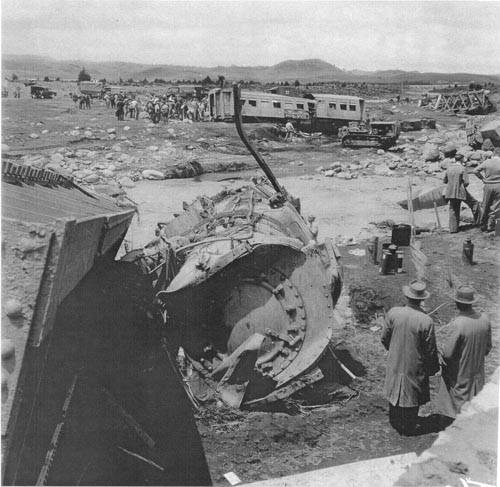OK so the Pacific Northwest is coming out of a wicked sick wind storm. There are down trees all over. As I was driving home I was looking at the trains parked on the tracks. It made me wonder, what do trains do when a tree falls across the tracks or a rock slide or snow slide or any other obstruction blocks the tracks. Trains travel along pretty fast and they don’t exactly stop on a dime. So what happens when something ends up on the tracks? How do they stop in time?
They try to send out a crew in a Hi-Railer to check the line for any obstructions. And train crews are probably more alert after a storm looking for stuff like that and are more then likely given a “slow order”.
The local that runs by here carries a chain saw in the cab. I’ve got a video somewhere that has them cutting up a fallen limb across the tracks. Course that train only travels about 25 MPH.
By the time an engineer can see a hazard it is usually far too late to stop and this happens:

Regards,
Peter.
I am sure more than a fair share of disasters have happen that way but I am sure many more have been avoided. Thanks Ken. I kinda figured some procedure was in place, just wondered what it was. The trains were stopped. I did not see any through trains and they normally go by at a rate of as many as 5-6 and hour and there were zero. At two of the locomotives a BNSF support car was there at the cab. . . dinner, maybe? A shuttle to a bunk house somewhere? What do they do when they unexpectedly have to stack up trains to do such inspections and clearing. The BNSF tracks through Spokane see as many as 80-100 trains a day from what I understand. What do they do when they have to stop them for a few hours?
A logistical nightmare I am sure but one that has been going on for 150 years. I would hope they have a plan of action. . .(http://www.largescalecentral.com/externals/tinymce/plugins/emoticons/img/smiley-wink.gif)
If possible, trains are routed over other track-age. Railroads will sometimes pay another railroad to use their track temporarily while repairs are made.
In slide areas, railroads will sometimes string signal wires beside the track. When current no longer flows through the wires, they know there has probably been a rock slide, and they send out a crew in a high railer to find out. I know the UP and SP had those kind of signal wire strung at certain places in the Rockies.
I had a buddy who used to pick up the train crews when they were done and either take them home or to a motel somewhere for the night. I’m sure if they’re not from that particular area, they’ll get them a room somewhere till they can get moving again.
Or, as in the case of the Amtrak Vermonter last summer, sometimes they are caught unaware with disastrous results. There had been a freight through that area a few hours earlier.
Lots of trains have crashed due to debris on tracks, washouts, etc. Here’s a video of a train that derailed when it hit a boulder on the tracks. It went down an embankment into the Wind River in Wyoming:
There is a reality show about the Alaska RR and those crews are always on the lookout for avalanches and ice forming on the rails or falling from tunnels and cliffs. They have guys that travel the main in work trucks and diggers that clear junk from the tracks. It is a full time job.
Trains that go through cities need to watch out for cars, shopping carts and other junk that is thrown onto the tracks. I know a guy that used to work on the New Haven and he said idiots used to hang cement blocks from bridges to hit the trains and try to get them through the windshields.
On my RR I have a problem with twigs and acorns.
Section gangs were responsible for their section of track and there was usually a walker who had a small cabin nearby.

John
Slide areas generally have a slide fence. When the slide fence is broken, it drops the signals, and you get a restricted speed. 20 mph max, must stop in 1/2 the range of vision. For “little” debris, you typically just run over it… When a big tree or slide comes down the MOW crews usually take care of it by either dumping it off the ROW or loading a railcar. A few years back BNSF got in big trouble from some folks in Seattle because they were dumping the cliff slide into Puget Sound (not that it wouldn’t have ended up in Puget Sound anyway if the RR tracks weren’t there…).
I’ve hit some pretty big stuff on the tracks and didn’t derail, but it was always a wonder if you would.
As for your location in the “Funnel” it could be a ton of different reasons from crews, to power outages, slides, etc.